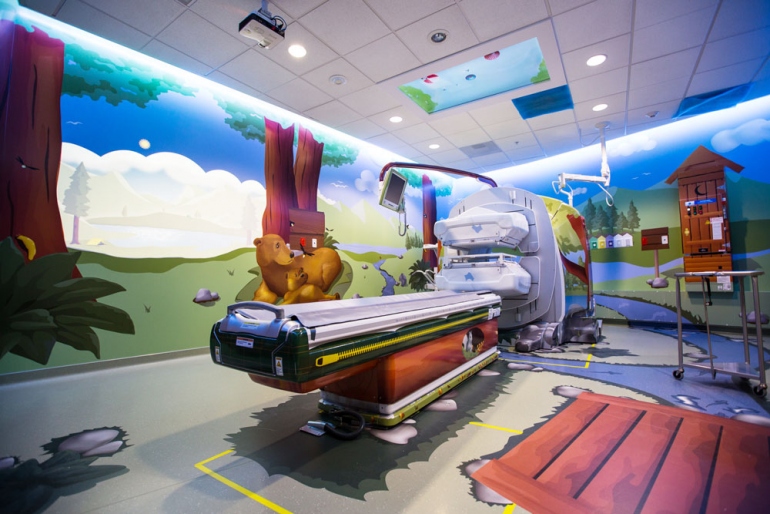Mission Bay Hospitals to Introduce Patient-Friendly Scan Suites

A fun forest-themed scan suite at the new UCSF Benioff Children's Hospital San Francisco. Photo by Elisabeth Fall
Patients undergoing imaging at the new UCSF Medical Center at Mission Bay will be transported to the tranquility of Muir Woods, or take in the sights of San Francisco from a cable car or boat, thanks to images projected on the suites’ walls and ceiling. They can admire lush visuals, such as a sunset over Golden Gate Bridge, and listen to the sounds of nature or soothing music that they select themselves.

UCSF staff check out a mock-up of one of the new scan suites developed by GE Healthcare.
Younger patients at the new UCSF Benioff Children’s Hospital San Francisco may prefer a more active role. Instead of a stark room with a table and scanning equipment, they may opt for the driver’s seat of a trolley car, where they can trundle around the city, take in local landmarks and participate in hands-on activities working with a cast of animated critters. Or perhaps they prefer to captain a boat for a nautical expedition.
These suites will be available when UCSF Medical Center at Mission Bay opens on February 1, 2015, for patients undergoing MRI or SPECT and CT, two imaging techniques that look inside the body and help doctors pinpoint any areas of disease. The procedures can take from 30 minutes to an hour and are used to diagnose a variety of conditions from tumors and congenital abnormalities, to skeletal trauma such as ACL injury.
Among cancer patients, scanning may be especially stressful because it determines the success or failure of treatment.
The design of the rooms was the result of collaboration between GE Healthcare and a UCSF team comprising faculty, staff, patients and their families participating in workshops and “visioning sessions” in which optimal features of the suites were identified and the feasibility of implementing them were discussed. Opinions were also sought from pediatric patients who viewed suite mock-ups.

John MacKenzie, MD
Making the scan suites child-friendly was the primary focus, said John MacKenzie, MD, chief of radiology at UCSF Benioff Children’s Hospital San Francisco, who provided a physician’s perspective and worked with the team from UCSF and GE Healthcare.
“Most children have never encountered an MRI machine before – it’s not something they see in a playground. Typically they enter an MRI room and hesitate when they’re told to hop on the table. But if instead they’re told, ‘Let’s go take a ride on the boat,’ they’re more likely to be intrigued than anxious,” said MacKenzie.
The child-friendly imaging suites enable parents to participate in the adventure, which can ease their own stress, he also noted. The themes of each room will help parents distract and interact with the child. For example, the parent might ask their child, “Can you find any birds in the room?”
It is hoped that the suites will reduce the number of patients that require additional imaging, because they move and reduce image quality, feel claustrophobic or are too nervous to remain still long enough to get adequate information.

Raina Sobel and her 4-year-old daughter Malia, a UCSF patient, provided feedback that helped develop the new scan suites.
“Currently about 10 percent of our patients, mostly children, need additional images that prolong their examination, and in the worst-case scenario, they might need to be brought back to radiolology for a repeat test. With the new suites at Mission Bay, we expect that this number will decline substantially,” said MacKenzie.
It is also anticipated that fewer people will require sedation or general anesthesia, which carries additional risks and costs that may be avoided.
Currently children at UCSF Benioff Children’s Hospital San Francisco undergoing scans are supported by staff from Child Life Services and are able to watch a movie during MRIs using video goggles.
“We already have a lot of success when imaging children without anesthesia; recently a 3-year-old patient was able to do this. With the new suites at Mission Bay, we expect our patients’ experiences to be even more positive,” said MacKenzie.
Raina Sobel, a member of the Family Advisory Council at UCSF, is one parent who participated in the workshops. Sobel’s 4-year-old daughter Malia was born with congenital diaphragmatic hernia, a condition affecting 1 in 2,500 babies that required months in the neonatal intensive care unit and long-term follow-up.
“The new scan suites offer a much more welcoming environment. I anticipate that it will make a dramatic difference in reducing Malia’s anxiety and improving her comfort,” said Sobel.
Photos courtesy of GE Healthcare